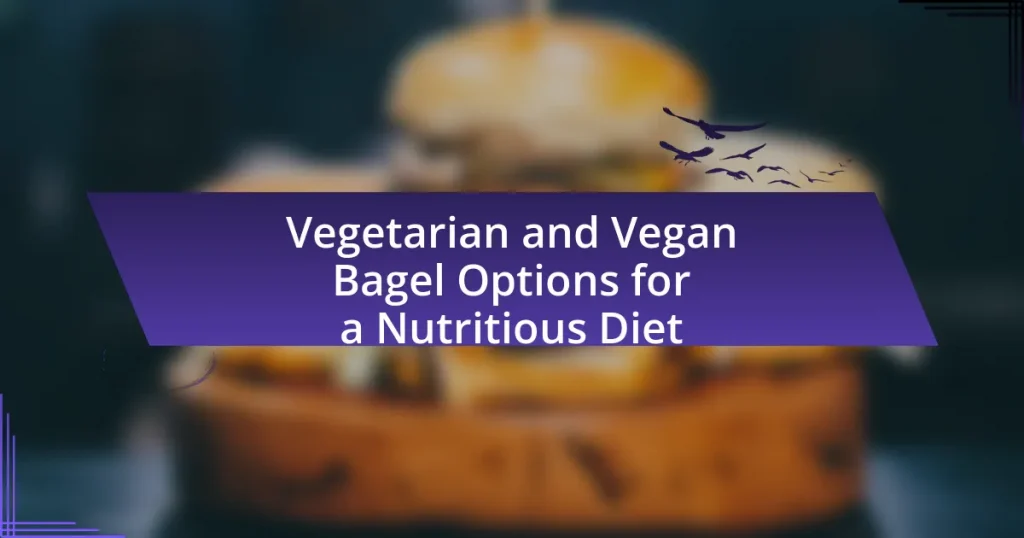Bagels serve as an effective component of a post-workout meal plan due to their high carbohydrate content, which aids in replenishing glycogen stores depleted during exercise. They can be paired with protein-rich toppings, such as cream cheese or smoked salmon, to support muscle repair and growth. The article outlines the nutritional benefits of bagels, including their carbohydrate and protein content, and discusses the importance of timing and portion control for optimal recovery. Additionally, it provides practical tips for incorporating bagels into post-workout nutrition, including quick recipes, ideal toppings, and storage methods to maintain freshness.

How can bagels be a part of a post-workout meal plan?
Bagels can be a part of a post-workout meal plan by providing a source of carbohydrates that replenish glycogen stores depleted during exercise. After a workout, the body requires carbohydrates for recovery, and bagels, typically made from refined flour, offer a quick source of energy. Additionally, bagels can be paired with protein-rich toppings, such as cream cheese or smoked salmon, to support muscle repair and growth. Research indicates that consuming carbohydrates and protein together post-exercise enhances recovery, making bagels an effective option for athletes and fitness enthusiasts.
What nutritional benefits do bagels provide after a workout?
Bagels provide essential carbohydrates and protein, making them beneficial for recovery after a workout. The carbohydrates in bagels replenish glycogen stores depleted during exercise, which is crucial for energy restoration. Additionally, bagels often contain protein, which aids in muscle repair and growth. For example, a standard bagel can contain around 45 grams of carbohydrates and 10 grams of protein, supporting both energy recovery and muscle synthesis. This combination of macronutrients makes bagels an effective option for post-workout nutrition.
How do carbohydrates in bagels aid in recovery?
Carbohydrates in bagels aid in recovery by replenishing glycogen stores depleted during exercise. After intense physical activity, the body requires carbohydrates to restore energy levels, and bagels provide a concentrated source of these essential nutrients. Research indicates that consuming carbohydrates post-exercise can enhance glycogen resynthesis, with a recommended intake of 1.0 to 1.2 grams of carbohydrates per kilogram of body weight within the first hour after exercise for optimal recovery. Bagels, typically containing around 45-60 grams of carbohydrates each, can effectively meet this requirement, making them a practical choice for athletes and active individuals.
What role do proteins play when combined with bagels post-exercise?
Proteins play a crucial role in muscle recovery and growth when combined with bagels post-exercise. The combination provides essential amino acids necessary for repairing muscle tissue that is stressed during workouts. Consuming protein alongside carbohydrates, such as those found in bagels, enhances glycogen replenishment, which is vital for restoring energy levels after exercise. Research indicates that a post-workout meal containing both protein and carbohydrates can significantly improve recovery outcomes, with a recommended ratio of 3:1 carbohydrates to protein for optimal results.
Why are bagels a convenient option for post-workout meals?
Bagels are a convenient option for post-workout meals because they provide a balanced combination of carbohydrates and protein, essential for recovery. The high carbohydrate content in bagels replenishes glycogen stores depleted during exercise, while the protein aids in muscle repair. For instance, a standard bagel contains approximately 45 grams of carbohydrates and 10 grams of protein, making it an effective choice for athletes and fitness enthusiasts. Additionally, bagels are portable and easy to prepare, allowing for quick consumption after workouts, which is crucial for maximizing recovery benefits.
How easy is it to prepare bagels after a workout?
Preparing bagels after a workout is quite easy and efficient. Bagels require minimal preparation time, typically just a few minutes to toast or heat them. This quick process allows individuals to refuel with carbohydrates and protein shortly after exercising, which is essential for recovery. The simplicity of bagel preparation, combined with their nutritional benefits, makes them an ideal choice for a post-workout meal.
What are some quick bagel recipes for post-workout nutrition?
Quick bagel recipes for post-workout nutrition include a peanut butter and banana bagel, a smoked salmon and cream cheese bagel, and a turkey and avocado bagel. The peanut butter and banana bagel provides protein and carbohydrates, essential for muscle recovery, while the smoked salmon and cream cheese bagel offers omega-3 fatty acids and protein, which support muscle repair. The turkey and avocado bagel combines lean protein and healthy fats, promoting satiety and recovery. These combinations are effective for replenishing energy and aiding muscle recovery after workouts.
What types of bagels are best for post-workout meals?
Whole grain bagels are best for post-workout meals due to their higher fiber content and complex carbohydrates, which aid in muscle recovery and replenish glycogen stores. Additionally, bagels made with protein-enriched flour can further support muscle repair and growth. Research indicates that consuming carbohydrates and protein after exercise enhances recovery, making these types of bagels particularly effective for athletes and fitness enthusiasts.
How do whole grain bagels compare to regular bagels in terms of nutrition?
Whole grain bagels are generally more nutritious than regular bagels due to their higher fiber content and greater amounts of vitamins and minerals. Whole grain bagels typically contain around 3-5 grams of fiber per serving, compared to 1-2 grams in regular bagels, which aids in digestion and promotes satiety. Additionally, whole grain varieties often provide more B vitamins, iron, and magnesium, essential for energy metabolism and muscle function. Studies indicate that diets high in whole grains are associated with lower risks of heart disease and improved overall health, reinforcing the nutritional advantages of whole grain bagels over their regular counterparts.
What toppings can enhance the nutritional value of bagels after exercise?
Nutritious toppings that can enhance the nutritional value of bagels after exercise include Greek yogurt, nut butter, avocado, smoked salmon, and cottage cheese. Greek yogurt provides protein and probiotics, aiding muscle recovery and gut health. Nut butter, such as almond or peanut butter, offers healthy fats and protein, which are essential for energy replenishment. Avocado adds monounsaturated fats and fiber, promoting satiety and nutrient absorption. Smoked salmon is rich in omega-3 fatty acids and protein, supporting muscle repair and reducing inflammation. Cottage cheese is high in casein protein, which digests slowly, providing a sustained release of amino acids for recovery. These toppings collectively contribute to a balanced post-workout meal, enhancing recovery and overall nutritional intake.

How can you effectively incorporate bagels into your post-workout routine?
To effectively incorporate bagels into your post-workout routine, consume a whole grain bagel within 30 to 60 minutes after exercising. This timing is crucial as it helps replenish glycogen stores and aids in muscle recovery. Whole grain bagels provide complex carbohydrates, which are essential for energy restoration, and they also contain some protein, which supports muscle repair. Research indicates that consuming carbohydrates and protein together post-exercise can enhance recovery and improve performance in subsequent workouts. Therefore, pairing a bagel with a source of protein, such as Greek yogurt or nut butter, can optimize the benefits of your post-workout meal.
What are some ideal times to consume bagels after a workout?
The ideal times to consume bagels after a workout are within 30 minutes to two hours post-exercise. This timeframe is crucial for optimizing recovery, as the body is primed to replenish glycogen stores and repair muscle tissue during this period. Consuming carbohydrates, such as bagels, shortly after a workout can enhance glycogen resynthesis, which is essential for athletes and active individuals. Research indicates that consuming carbohydrates within this window can significantly improve recovery outcomes, making bagels a suitable choice for post-workout nutrition.
How soon after exercising should you eat a bagel?
You should eat a bagel within 30 minutes to two hours after exercising. This timeframe is optimal for replenishing glycogen stores and aiding muscle recovery. Research indicates that consuming carbohydrates, like those found in a bagel, shortly after exercise enhances recovery and performance in subsequent workouts.
What portion sizes are recommended for post-workout bagel meals?
For post-workout bagel meals, a recommended portion size is one to two bagels, depending on individual energy needs and workout intensity. Research indicates that consuming carbohydrates post-exercise aids in glycogen replenishment, and bagels provide a convenient source of carbohydrates, with one medium bagel containing approximately 45-50 grams of carbs. Therefore, pairing one bagel with a protein source, such as Greek yogurt or turkey, can optimize recovery and muscle repair.
How can bagels be paired with other foods for a balanced meal?
Bagels can be paired with protein sources, healthy fats, and fruits or vegetables to create a balanced meal. For instance, a bagel topped with cream cheese and smoked salmon provides protein and omega-3 fatty acids, while adding avocado offers healthy fats. Incorporating sliced tomatoes or cucumbers adds vitamins and minerals, enhancing the meal’s nutritional profile. This combination not only satisfies hunger but also supports muscle recovery and overall health, making it an effective post-workout option.
What are some protein-rich toppings to add to bagels?
Protein-rich toppings to add to bagels include cream cheese, Greek yogurt, smoked salmon, cottage cheese, and nut butters. Cream cheese contains about 2 grams of protein per tablespoon, while Greek yogurt offers approximately 10 grams of protein per 100 grams. Smoked salmon provides around 18 grams of protein per 3 ounces, and cottage cheese contains about 14 grams of protein per half-cup serving. Nut butters, such as almond or peanut butter, typically have around 7 grams of protein per 2 tablespoons. These toppings enhance the protein content of bagels, making them suitable for post-workout recovery.
How can fruits or vegetables complement bagels in a post-workout meal?
Fruits and vegetables can complement bagels in a post-workout meal by providing essential vitamins, minerals, and antioxidants that aid in recovery. For instance, bananas, rich in potassium, help replenish electrolytes lost during exercise, while spinach offers iron and magnesium, which are crucial for muscle function. Additionally, berries contain antioxidants that reduce inflammation and promote faster recovery. The combination of bagels, which provide carbohydrates for energy replenishment, with fruits or vegetables enhances overall nutrient intake, supporting muscle repair and energy restoration after workouts.
What are common mistakes to avoid when incorporating bagels into a post-workout meal?
Common mistakes to avoid when incorporating bagels into a post-workout meal include choosing bagels with excessive added sugars and neglecting protein pairing. Excessive sugars can lead to rapid spikes in blood sugar, which may hinder recovery, while a lack of protein can prevent muscle repair. Research indicates that a balanced post-workout meal should ideally include carbohydrates and protein in a 3:1 ratio for optimal recovery. Therefore, selecting whole grain bagels and pairing them with a protein source, such as Greek yogurt or turkey, enhances the nutritional value and supports recovery effectively.
How can excessive toppings detract from the benefits of bagels?
Excessive toppings can detract from the benefits of bagels by significantly increasing calorie content and altering the nutritional balance. Bagels are typically a source of carbohydrates, which are essential for post-workout recovery; however, when overloaded with high-calorie toppings like cream cheese, butter, or sugary spreads, the overall caloric intake can exceed what is beneficial for recovery. This can lead to unwanted weight gain and negate the energy-boosting advantages of the bagel itself. Additionally, excessive toppings may introduce unhealthy fats and sugars, which can undermine the health benefits associated with consuming whole grains found in bagels.
What should you consider regarding portion control with bagels?
When considering portion control with bagels, it is essential to recognize that a standard bagel typically contains around 250 to 300 calories, which can significantly impact overall caloric intake. To manage portion sizes effectively, individuals should consider consuming half a bagel or opting for smaller varieties, such as mini bagels, to align with their dietary goals. Research indicates that controlling portion sizes can help prevent excessive calorie consumption, which is crucial for maintaining a balanced post-workout meal plan.

What practical tips can enhance your post-workout bagel meals?
To enhance your post-workout bagel meals, focus on adding protein-rich toppings such as Greek yogurt, cottage cheese, or nut butter. These toppings provide essential amino acids that aid in muscle recovery. Additionally, incorporating fruits like bananas or berries can offer carbohydrates and antioxidants, which help replenish glycogen stores and reduce inflammation. For optimal hydration, consider pairing your bagel with a glass of water or a low-sugar electrolyte drink to support recovery.
How can meal prepping bagels improve your post-workout nutrition?
Meal prepping bagels can significantly enhance post-workout nutrition by providing a convenient source of carbohydrates and protein essential for recovery. Bagels, typically made from refined flour, offer a quick-digesting carbohydrate option that replenishes glycogen stores depleted during exercise. Additionally, when paired with protein-rich toppings such as cream cheese, nut butter, or smoked salmon, bagels can help repair muscle tissue and promote recovery. Research indicates that consuming carbohydrates and protein within 30 minutes post-exercise optimizes recovery, making meal-prepped bagels an effective choice for athletes and fitness enthusiasts.
What are some easy ways to prepare bagels in advance?
To prepare bagels in advance, you can freeze them after baking or purchasing. Freezing bagels preserves their freshness and allows for easy reheating. Simply place the bagels in a resealable plastic bag or airtight container, ensuring to remove as much air as possible to prevent freezer burn. When ready to eat, you can toast them directly from the freezer or let them thaw at room temperature before toasting. This method is effective because bagels can maintain their quality for up to three months in the freezer, making them a convenient option for post-workout meals.
How can you store bagels to maintain freshness for post-workout meals?
To maintain freshness for bagels intended for post-workout meals, store them in an airtight container or resealable plastic bag at room temperature for up to two days. This method prevents moisture loss and keeps the bagels soft. For longer storage, freeze bagels by wrapping them individually in plastic wrap and placing them in a freezer-safe bag, which can preserve their quality for up to three months. When ready to eat, thaw at room temperature or toast directly from the freezer. This approach is supported by food storage guidelines that emphasize the importance of minimizing air exposure to maintain texture and flavor.
What are some creative ways to enjoy bagels after a workout?
Bagels can be creatively enjoyed after a workout by transforming them into nutritious meals or snacks. One option is to top a whole grain bagel with Greek yogurt and fresh fruit, providing protein and carbohydrates essential for recovery. Another idea is to create a bagel sandwich with lean turkey, avocado, and spinach, which offers healthy fats and vitamins. Additionally, spreading almond butter on a bagel and adding banana slices delivers a quick source of energy and potassium. These combinations not only enhance the flavor but also contribute to muscle recovery and overall nutrition post-exercise.
How can you experiment with different flavors and toppings for variety?
To experiment with different flavors and toppings for variety, you can combine various spreads, proteins, and toppings on bagels. For instance, using cream cheese with herbs, avocado, or nut butter can create distinct flavor profiles. Additionally, incorporating toppings like smoked salmon, tomatoes, or fresh fruits can enhance the taste and nutritional value. Research indicates that flavor variety can increase meal satisfaction and encourage healthier eating habits, making it beneficial to explore diverse combinations.
What are some cultural bagel dishes that can be adapted for post-workout meals?
Cultural bagel dishes that can be adapted for post-workout meals include the classic New York bagel with cream cheese and smoked salmon, which provides protein and healthy fats essential for recovery. Additionally, the Montreal-style bagel topped with sesame seeds can be paired with cottage cheese and fruit for a balanced meal rich in carbohydrates and protein. Another option is the Jewish bagel sandwich filled with turkey and avocado, offering lean protein and healthy fats. These adaptations maintain the cultural essence of the dishes while providing the necessary nutrients for post-exercise recovery.



